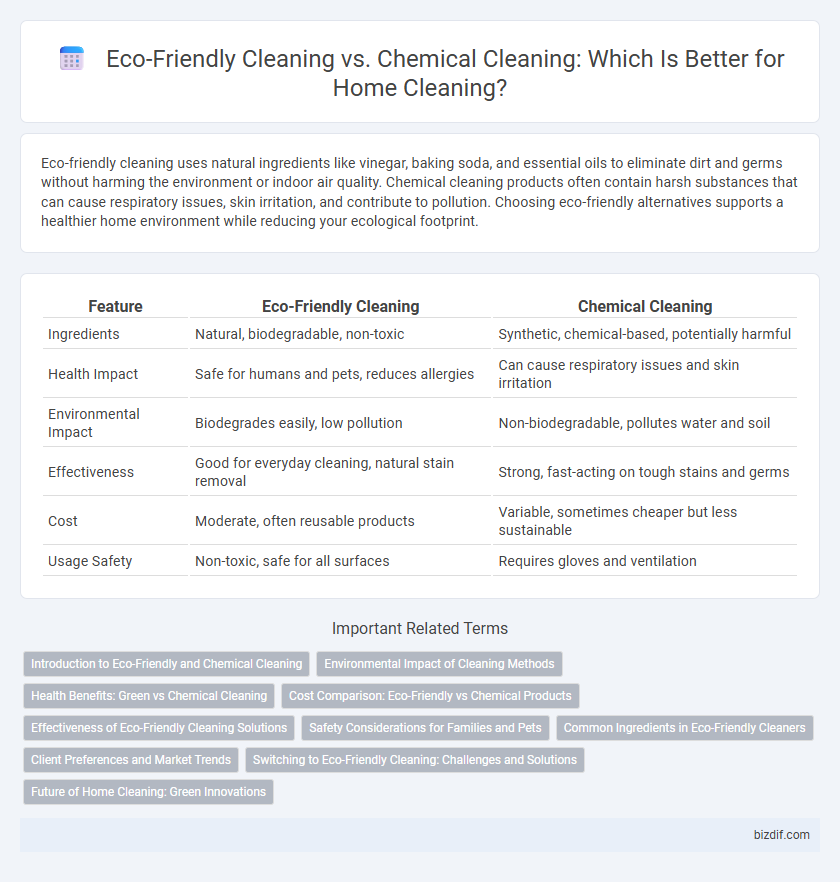Eco-friendly cleaning uses natural ingredients like vinegar, baking soda, and essential oils to eliminate dirt and germs without harming the environment or indoor air quality. Chemical cleaning products often contain harsh substances that can cause respiratory issues, skin irritation, and contribute to pollution. Choosing eco-friendly alternatives supports a healthier home environment while reducing your ecological footprint.
Table of Comparison
| Feature | Eco-Friendly Cleaning | Chemical Cleaning |
|---|---|---|
| Ingredients | Natural, biodegradable, non-toxic | Synthetic, chemical-based, potentially harmful |
| Health Impact | Safe for humans and pets, reduces allergies | Can cause respiratory issues and skin irritation |
| Environmental Impact | Biodegrades easily, low pollution | Non-biodegradable, pollutes water and soil |
| Effectiveness | Good for everyday cleaning, natural stain removal | Strong, fast-acting on tough stains and germs |
| Cost | Moderate, often reusable products | Variable, sometimes cheaper but less sustainable |
| Usage Safety | Non-toxic, safe for all surfaces | Requires gloves and ventilation |
Introduction to Eco-Friendly and Chemical Cleaning
Eco-friendly cleaning utilizes natural ingredients like vinegar, baking soda, and essential oils to effectively remove dirt while minimizing environmental impact and health risks. Chemical cleaning relies on synthetic compounds such as bleach, ammonia, and phosphates, which provide strong disinfecting power but may introduce toxins into indoor air and waterways. Choosing eco-friendly methods supports sustainable living by reducing pollution and promoting safer indoor environments.
Environmental Impact of Cleaning Methods
Eco-friendly cleaning methods use biodegradable ingredients that reduce water and soil contamination, minimizing harm to aquatic life and ecosystems. Chemical cleaning products often contain toxic substances like ammonia and chlorine, which contribute to air pollution and persist in the environment, leading to long-term ecological damage. Choosing natural cleaning agents such as vinegar, baking soda, and plant-based detergents promotes sustainability and lowers the carbon footprint associated with home maintenance.
Health Benefits: Green vs Chemical Cleaning
Eco-friendly cleaning products use natural ingredients that reduce exposure to harmful chemicals, minimizing respiratory issues and skin irritations commonly triggered by conventional chemical cleaners. Green cleaning often includes biodegradable substances that improve indoor air quality by releasing fewer volatile organic compounds (VOCs) compared to chemical alternatives. Choosing eco-friendly cleaning methods supports long-term health benefits by decreasing toxic buildup in the home environment and protecting sensitive individuals such as children and those with allergies.
Cost Comparison: Eco-Friendly vs Chemical Products
Eco-friendly cleaning products generally have a higher upfront cost compared to traditional chemical cleaners, but their long-term expenses are often lower due to reduced health risks and environmental impact. Chemical cleaning products may appear cheaper initially, but potential costs related to respiratory issues, skin irritation, and environmental damage can accumulate over time. Investing in eco-friendly options supports sustainable living and can lead to savings in medical bills and waste management fees, making them more cost-effective in the long run.
Effectiveness of Eco-Friendly Cleaning Solutions
Eco-friendly cleaning solutions leverage natural ingredients like vinegar, baking soda, and essential oils to effectively break down dirt, grease, and grime without harmful residues. Studies show these biodegradable products maintain high performance in removing allergens and bacteria while enhancing indoor air quality. Their efficiency in household cleaning matches traditional chemical cleaners while minimizing environmental impact and health risks.
Safety Considerations for Families and Pets
Eco-friendly cleaning products prioritize non-toxic ingredients that reduce health risks for families and pets, minimizing exposure to harmful chemicals often found in traditional cleaning agents. Chemical cleaning products can release volatile organic compounds (VOCs) and residues that may cause allergies, respiratory issues, or skin irritations in sensitive individuals. Opting for biodegradable, plant-based cleaners ensures a safer home environment, protecting children and animals from potential hazards.
Common Ingredients in Eco-Friendly Cleaners
Eco-friendly cleaning products commonly contain biodegradable ingredients like plant-based surfactants, essential oils, and natural enzymes that break down dirt without harming the environment. These cleaners often utilize vinegar, baking soda, and citric acid, which provide effective stain and odor removal while being non-toxic and safe for households with children and pets. Organic ingredients minimize indoor air pollution and reduce chemical residues compared to traditional chemical cleaning agents containing ammonia, chlorine, and synthetic fragrances.
Client Preferences and Market Trends
Eco-friendly cleaning products are gaining significant traction among clients who prioritize health and environmental sustainability, reflecting a growing market trend towards green solutions. Chemical cleaning agents, despite their efficacy, face declining demand due to concerns over toxicity and harsh environmental impact. Market analysis indicates that brands offering biodegradable, non-toxic cleaning options experience higher customer loyalty and increased sales in urban and eco-conscious demographics.
Switching to Eco-Friendly Cleaning: Challenges and Solutions
Switching to eco-friendly cleaning presents challenges such as higher initial costs, limited product availability, and skepticism about performance compared to chemical alternatives. Solutions include investing in concentrated, multi-purpose eco-friendly products to reduce expenses, sourcing from reputable green brands certified by organizations like EcoLogo or Green Seal, and educating consumers on the efficacy and health benefits of natural ingredients like vinegar, baking soda, and essential oils. Emphasizing long-term environmental impact and indoor air quality improvements encourages broader adoption of sustainable cleaning practices.
Future of Home Cleaning: Green Innovations
The future of home cleaning centers on green innovations that prioritize eco-friendly cleaning methods over traditional chemical solutions, reducing indoor air pollution and minimizing environmental impact. Advanced technologies like biodegradable detergents, plant-based solvents, and energy-efficient cleaning devices are transforming residential maintenance by promoting sustainable practices. These innovations not only improve occupant health but also support global efforts in carbon footprint reduction and waste management.
Eco-Friendly Cleaning vs Chemical Cleaning Infographic

 bizdif.com
bizdif.com